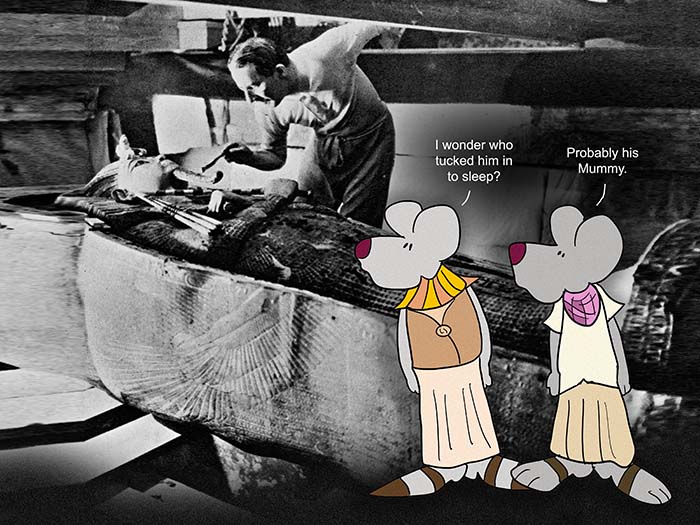I don’t know where to begin this story, really, as it has three parts. So I’ll start on our dining room floor, at 134 E. Bruce Ave., in Dayton, on the lump of pillows in the corner, where we sat and watched TV, an old black and white model.
After cartoons and after our chores were done on Saturday mornings, we could watch the Saturday Mystery Theatre movie. It could have been anything from Vincent Price’s Pit and the Pendulum, to Dr. Jekyll and Mr. Hyde. But the one that got me was The Mummy starring Boris Karloff, or any of those creepy Egyptian movies, where they explored the tombs beneath the surface of the sand. That is when I became fascinated with the tombs of Egypt.
So, today, it still catches my eye whenever I see news about those places. Today, historically speaking, is one of those days. It was on November 4, 1922, when Howard Carter discovered the incredible tomb of the Pharaoh Tutankhamun in Egypt.
It wasn’t as if old Howard was walking along and flung some door open, saying, “Well, looky who’s here!” No. It started when Howard was born.
It happened in Kensington in 1874. Howard was the youngest child of eleven. The son of artist and illustrator Samuel John Carter and Martha Joyce (née Sands). His father helped train and develop his artistic talents, which ended up leading to his life as an archaeologist and Egyptologist.
Little Howard spent much of his childhood with relatives in the Norfolk market town of Swaffham. There, he received an extremely limited formal education. But he always showed talent as an artist.
Near him was the mansion of the Amherst family. It contained a sizable collection of Egyptian antiques, and this sparked Howard’s interest in Egypt. Lady Amherst was impressed by his artistic skills. So, in 1891, she put some heavy prompting on the Egypt Exploration Fund and suggested they send Howard to “assist an Amherst family friend, Percy Newberry, in the excavation and recording of Middle Kingdom tombs at Beni Hasan.”
And that’s what got the ball rolling. I won’t go into all the details of his upward climb through the “world of archeology.” But it began here when Howard was only 17. He was innovative in improving the methods of copying tomb decorations. He went on job after job, learning the skills, watching the methods of the men above him. He learned by having his hands-on, but at the same time, thinking of better ways of doing things.
By 1899, Carter was appointed Inspector of Monuments for Upper Egypt in the Egyptian Antiquities Service. He oversaw a number of excavations and restorations at nearby Thebes.
But. Here is a big thing. In 1904, there was a dispute with local people over tomb thefts. He was sent to inspect. Howard was “praised for his improvements in the protection of, and accessibility to, existing excavation sites, and his development of a grid-block system for searching for tombs.”
His story goes on. But mostly, his hard work brought him to the point of finding Tut. Carter returned to the Valley of Kings to investigate a line of huts that he had abandoned a few seasons earlier. The crew cleared the huts rock debris.
Then, their young water boy accidentally stumbled on a stone that turned out to be the top of a flight of steps cut into the bedrock. Howard found the top of a mud-plastered doorway underneath. King Tut. Funky Tut.
The rest we have seen — the glory of that tomb. King Tutankhamun ruled Egypt as pharaoh for ten years until his death at age 19. This, around 1324 B.C. The ancient Egyptian pharaoh was the last of his royal family to rule during the end of the glorious 18th Dynasty.
His father and mother were brother and sister. Tut himself married his half-sister. They kept it all in the family, I suppose.
Regardless, this was a story of Howard Carter, following his interests. He worked hard at learning and becoming. He was a man of character and integrity, and these traits showed clearly in his work.
It is something any of us can apply to any part of our lives. Learning and becoming. It is a wondrous thing, to think that no matter what our interests, we have the potential to learn and become. To be.
And find our own hidden doorways.
=========
“It is not that I’m so smart. But I stay with the questions much longer.”
― Albert Einstein
=========
“Education is the kindling of a flame, not the filling of a vessel.”
― Socrates
=========
“Wisdom…. comes not from age, but from education and learning.”
― Anton Chekhov
==========
Finding the underneath, more than Tut. Funky Tut.
